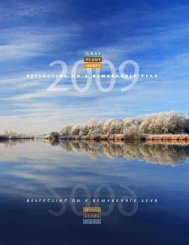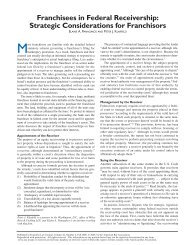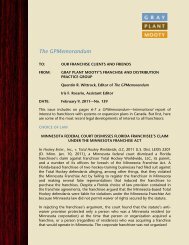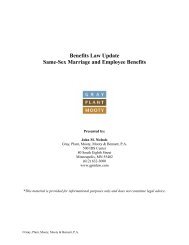Los Angeles Lawyer October 2008 - Gray Plant Mooty
Los Angeles Lawyer October 2008 - Gray Plant Mooty
Los Angeles Lawyer October 2008 - Gray Plant Mooty
Create successful ePaper yourself
Turn your PDF publications into a flip-book with our unique Google optimized e-Paper software.
to exclude potential jurors “on account of<br />
race” violated the equal protection clause. 4<br />
The Court, however, recognized a presumption<br />
that prosecutors properly exercise<br />
peremptory challeges—and placed on defendants<br />
the burden of proving discriminatory<br />
intent. Thus defendants were required to<br />
show that a prosecutor intentionally used<br />
challenges to deny African American potential<br />
jurors “the same right and opportunity<br />
to participate in the administration<br />
of justice enjoyed by the white<br />
population” for “reasons wholly<br />
unrelated to the outcome of the<br />
particular case on trial.” 5 Applying<br />
these standards in Swain,<br />
the Court found no equal protection<br />
violation despite the prosecutor’s<br />
striking of all six African<br />
American potential jurors and<br />
despite evidence that no African<br />
American had served on a criminal<br />
petit jury in Alabama since approximately<br />
1950. A number of lower courts interpreted<br />
Swain as requiring defendants to present<br />
“proof of repeated striking of blacks over<br />
a number of cases,” a “crippling” burden<br />
that left prosecutors’ peremptory challenges<br />
“largely immune from constitutional<br />
scrutiny.” 6<br />
The California Supreme Court rejected<br />
this approach in 1978, holding in People v.<br />
Wheeler that under the California Constitution,<br />
the presumption that peremptories<br />
are properly exercised could be overcome<br />
with a prima facie showing based solely on<br />
the pattern of peremptories in a given case.<br />
Once this showing was made, the burden<br />
would shift to the other party to “show that<br />
the peremptory challenges in question were<br />
not predicated on group bias alone.” 7 In<br />
1986, the U.S. Supreme Court followed suit,<br />
rejecting Swain’s approach in Batson v.<br />
Kentucky. In Batson, the Court reiterated<br />
that while a defendant has no right to a jury<br />
composed in whole or in part by members of<br />
his or her own race, the defendant unequivocally<br />
has the right “to be tried by a jury<br />
whose members are selected pursuant to<br />
nondiscriminatory criteria.” 8 The Court held<br />
that the required initial prima facie showing<br />
of discriminatory intent could be made based<br />
“solely on evidence concerning the prosecutor’s<br />
exercise of peremptory challenges at the<br />
defendant’s trial.” 9 Further, the Court adopted<br />
what has developed into the now familiar<br />
three-step process for challenging peremptory<br />
strikes:<br />
[O]nce the opponent of a peremptory<br />
challenge has made out a prima facie<br />
case of racial discrimination (step one),<br />
the burden of production shifts to the<br />
proponent of the strike to come forward<br />
with a race-neutral explanation<br />
Elimination of<br />
(step two). If a race-neutral explanation<br />
is tendered, the trial court must then<br />
decide (step three) whether the opponent<br />
of the strike has proved purposeful<br />
racial discrimination. 10<br />
Although Batson involved an African<br />
American defendant objecting to the prosecutor’s<br />
systematic removal of African<br />
American jurors, the Court subsequently held<br />
that race-based exclusions could be challenged<br />
by any defendant, even if<br />
the excluded jurors were members<br />
of a race different from the<br />
defendant’s. 11 Also, Batson’s equal<br />
protection analysis has been<br />
applied to peremptories exercised<br />
by defense attorneys. 12 Subsequent<br />
decisions have extended<br />
Batson to civil cases. 13<br />
Though Batson limited its holding<br />
to race, in J.E.B. v. Alabama ex<br />
rel. T.B., the Court has extended<br />
Batson to peremptory challenges based on<br />
gender. 14 The Court, however, denied certiorari<br />
in a case that would have resolved<br />
the applicability of Batson to peremptory<br />
challenges based on religion. 15<br />
The California Supreme Court’s holding<br />
in Wheeler was not limited to race, referring<br />
instead to “group bias” and indicating that<br />
this meant “members of an identifiable group<br />
distinguished on racial, religious, ethnic, or<br />
similar grounds.” 16 In accordance with this<br />
approach, California courts have held that<br />
peremptory challenges based on religion and<br />
sexual orientation are impermissible. 17 In<br />
2000, the California Legislature added a<br />
statute prohibiting the use of a “peremptory<br />
challenge to remove a prospective juror on the<br />
basis of an assumption that the prospective<br />
juror is biased merely because of his or her<br />
race, color, religion, sex, national origin, sexual<br />
orientation, or similar grounds.” 18<br />
Jury Selection Methods<br />
In California, the exercise of peremptories is<br />
governed by statute, which provides that<br />
“peremptory challenges shall be taken or<br />
passed by the sides alternately,” that “each<br />
party shall be entitled to have the panel full<br />
before exercising any peremptory challenge,”<br />
and that the “number of peremptory challenges<br />
remaining with a side shall not be<br />
diminished by any passing of a peremptory<br />
challenge.” 19 In federal court, there is no<br />
similar governing statute and the only rule<br />
addressing peremptory challenges, Federal<br />
Rule of Criminal Procedure 24(b), “does not<br />
prescribe any method for the exercise of those<br />
challenges. Rather, ‘trial courts retain a broad<br />
discretion to determine the way peremptory<br />
challenges will be exercised.’” 20 As a result,<br />
federal courts employ a range of differing<br />
jury selection methods.<br />
California’s statute, codified at Code of<br />
Civil Procedure Section 231(d), makes it most<br />
likely that a California court will use some<br />
variant of the “jury box” method. This<br />
involves 12 prospective jurors being seated in<br />
the jury box and subjected to voir dire. In this<br />
method’s purest form, when a party exercises<br />
a challenge, whether for cause or a<br />
peremptory, a new juror is drawn at random<br />
from the remaining venire to be seated, questioned,<br />
and subject to challenge. 21 The parties<br />
thus know the precise composition of<br />
the potential jury panel at the time they elect<br />
whether or not to exercise peremptory challenges,<br />
but they do not know which juror<br />
from the venire will replace a challenged<br />
juror. The focus when exercising peremptories<br />
under this system, therefore, is primarily<br />
on the individual juror in context with those<br />
in the box at the time, as opposed to the<br />
potential overall makeup of the jury panel,<br />
which cannot be known at the time an individual<br />
challenge is exercised. 22<br />
When exercising peremptories under the<br />
jury box method, parties must be sure to<br />
understand the effect of passing. The Ninth<br />
Circuit has stated that a court may not treat<br />
a pass as a waiver of the passed peremptory<br />
23 but may treat a pass as a waiver of the<br />
subsequent ability to reach back and exercise<br />
a challenge against a juror who was in the jury<br />
box at the time of the pass. 24<br />
A variant on the jury box method seats<br />
and conducts voir dire on some additional<br />
number of jurors (most commonly 6) outside<br />
the jury box at the same time 12 are seated<br />
in the box. This typically saves time by permitting<br />
replacements for jurors challenged<br />
within the box to be drawn from a pool of<br />
prospective jurors who have already been<br />
subjected to voir dire.<br />
The “struck jury” method is another common<br />
form of jury selection. Under this system,<br />
voir dire is conducted on an entire venire.<br />
Thereafter:<br />
[A]n initial panel is drawn by lot from<br />
those members of the array who have<br />
not been challenged and excused for<br />
cause; the size of this initial panel<br />
equals the total of the number of petit<br />
jurors who will hear the case (twelve<br />
in a federal criminal case), plus the<br />
combined number of peremptories<br />
allowed to both sides (normally sixteen<br />
in federal felony trials, Fed. R. Crim.<br />
P. 24(b)). Counsel for each side then<br />
exercise their peremptory challenges,<br />
usually on an alternating basis, against<br />
the initial panel until they exhaust<br />
their alloted number and are left with<br />
a petit jury of twelve. 25<br />
A variant of the struck jury system is the<br />
“blind strike” method. Under this method,<br />
rather than alternating peremptories against<br />
26 <strong>Los</strong> <strong>Angeles</strong> <strong>Lawyer</strong> <strong>October</strong> <strong>2008</strong>







